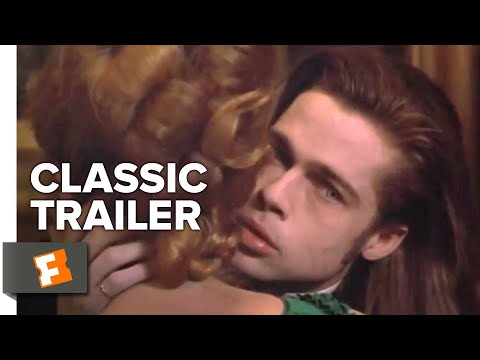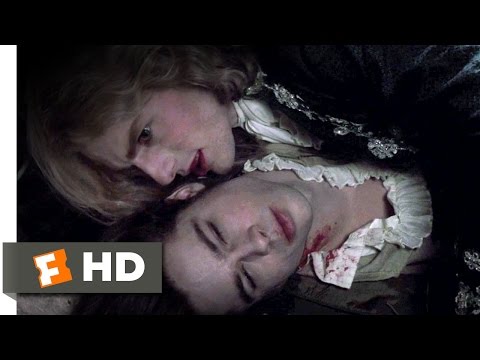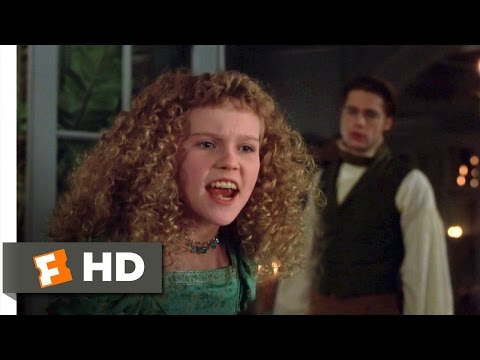Neil Jordan’s “Interview with the Vampire” (1994) begins with dreamy aerial shots of San Francisco, drawing us in with Elliot Goldenthal’s beautiful, melancholic score (similar to his music for “Alien 3”) and Phillipe Rousselot’s lush cinematography.
We push in on an empty room, inhabited by a bespeckled Christian Slater, playing the Interviewer, about to bear witness to the story of the lifetime from the longhaired figure staring out the window.
It’s Brad Pitt playing a vampire named Louis.

So begins “Interview with the Vampire: The Vampire Chronicles” (the full onscreen title), the most anticipated film of its year and easily among the most controversial. The latter quality came from its casting, the outcry from its author and screenwriter Anne Rice and the expectation that the film would betray its source material.
More on that later.
Louis recalls how he became a vampire in 1791, whereupon his sorrow-drenched life took a turn for the worse once he received the fateful bite of the vampire Lestat (Tom Cruise). During their years together as a pair of murdering night prowlers, they “adopt” Claudia, a child, played by an 11-year-old Kirsten Dunst.
Night after night, they drink the blood of the innocent in order to survive, a tediously cyclical lifestyle that Lestat relishes, but Louis quickly finds horrible.
The second act portrays a hidden world of vampires as thespian monsters, living in a theater that bears an awesome underground world. This extended section feels like a completely different movie, though spectacular moments carry it through to a striking finish.
The casting is key to where the film both succeeds and stumbles.
Cruise was no one’s first pick for Lestat. Indeed, Rice claimed she wanted Cruise for Louis and, at one point, Rutger Hauer for Lestat, though she defended Cruise’s performance after seeing the film.
There was even the Innovation comic book adaptation, which began in 1991 and, by the end of its run, had Louis appearing exactly like Cruise. Everyone familiar with the novel had an opinion on the subject.

Truth be told, Cruise gets into the spirit of the film, giving his all to a vile, privileged, and hateful character. The actor has given better performances, but he goes all in here.
I wish I could say the same for Pitt, whose performance is only half-there. I suspect the actor would be better at playing Louis today, whereas Cruise would likely still be a spot-on Lestat (Cruise’s ageless zeal with each passing decade is, after all, kind of vampiric).
It wouldn’t be a problem that Cruise is so robust here, and Pitt, well, isn’t, if Cruise’s performance weren’t just an extended cameo. This is Pitt’s film, and his performance is too similar to his equally uneven turn in “Legends of the Fall” (from the same year). Pitt has humbly admitted over the years that he wasn’t in a good head space when he played Louis (months of night shoots will do that to you).
Considering how gleefully nasty and funny Cruise is here, and how well he collaborated with older actors (such as Paul Newman and Dustin Hoffman), I can imagine Rice’s dream vision of this movie with Hauer and Cruise being far better.
Despite the lack of chemistry between Cruise and Pitt, Dunst’s scenes with Cruise are electric and Antonio Banderas is so hypnotic as Armand the vampire, it’s enough to make me wish the studio had kept going with The Vampire Chronicles. Stephen Rea, in a weird turn that couldn’t have been more unlike his prior lead in Jordan’s “The Crying Game” (1992), strikingly resembles Lon Chaney Jr. from “London After Midnight” (1927).

Further film and vampire history can be found in a great reference to Bram Stoker (“the vulgar fictions of a demented Irishman”) and I love how Louis is finally able to witness a sunrise, through the miracle of cinema. There’s also a funny reference to “Tequila Sunrise” (1988), only for its title (ah, to think of Mel Gibson paired as Lestat to Cruise’s Louis- another preferable fantasy pairing).
Despite Pitt’s sleepy turn, the rest of the ensemble and Jordan’s strong direction keep it moving. Dunst is amazing in her first starring role. Slater is excellent, ideally cast and filling in for the late River Phoenix, who was scheduled to play the role before his tragic death.
Many complained that the film dialed down the novel’s eroticism, particularly between Lestat and Louis and that the film was too tame. Both complaints are ridiculous, as Rice’s novel and this adaptation are about dealing with loss and guilt, not the joy of sex.
The erotic tension between the characters is addressed in the dialogue but never made explicit.
Rice’s novel was famously a means of mourning her own devastating personal loss – the film matches the book’s tone. Reports of some of the bloodier moments being cut to maintain an R-rating don’t appear to have softened the film, as the gore is frequent and disgusting.
So is the moral dilemma at hand – Louis can’t believe he has to become a killer, let alone bear witness to Lestat’s casual slaughters on a nightly basis.
Brad Pitt apparently wanted Daniel Day-Lewis to star opposite him in “Interview With a Vampire,” but Tom Cruise was cast instead. Filmmaker Neil Jordan remembers “the outrage that followed.”
“The entire world said, ‘You are miscast.’ He’s a great actor. If [Tom] says he can do… pic.twitter.com/szcAVVtgA0
— Variety (@Variety) June 14, 2024
Jordan’s film is overloaded with visionary moments, such as Louis’ initial glimpse of the world through “vampire eyes,” allowing him to see a lovely statue in a cemetery appear to judge him with a fearful glance. There’s also the repeated, knockout spectacle of vampires flying while engulfed in flames, and the staircase to Armand’s lair is jaw dropping.
Every time Cruise appears under piles of make-up to convey Lestat in a vulnerable state, the ambition of the make-up and in Cruise’s robust performance connect. Stan Winston provided some of the film’s grosser moments, of which there are many.
Like a Hammer horror film but presented as Masterpiece Theater and with a massive budget, Jordan gives it a classy presentation but, even with a pruned running time to meet the R-rating, it’s still a grisly work. That’s particularly true for a mainstream studio film opening around Christmas (!).
FAST FACT: “Interview with a Vampire” cracked the $100 million mark at the U.S. box office in 1994 – $105 million. That’s good for 10th place on that year’s box office list.
Rice’s screenplay generously truncates a busy story and helpfully leans into the morbid humor. Otherwise, it’s a dark, unsettling tale from start to finish.
Despite the strength of this achievement, Jordan’s “Mona Lisa” (1986) and “The Crying Game” (1992) are still his best films and superior works on family units that form from outsiders seeking comfort in an environment of moral rot.
As for the final scene, it’s a lot like the “Sympathy for the Devil” cover by Guns N’ Roses that plays over the credits.
It’s amusing but a little off.
The failure of the only sequel to date, “Queen of the Damned” (2002), which featured none of the original team, and the success of the 2022 AMC TV series becoming a beloved adaptation, has made Jordan’s film a once-in-a-lifetime anomaly.

While other lavish, star-studded vampire epics have emerged subsequently, Jordan’s proposed film series never got past the first entry (at least, not with his involvement). While a big hit at the time of release, it remains a divisive work and, because of how good the AMC series is, it is no longer the definitive adaptation of the source material.
There are problems with Jordan’s film, namely Pitt and the pacing. Yet, what does work (the majority of the performances, the power of many scenes and the production itself) is enough to overcome the shortcomings.
While an eternally divisive topic, Cruise’s highly debated performance holds up better than anyone remembers. Dunst, Banderas and Slater are terrific and the heartbreak and reflection on the value of life from Rice’s defining novel are on hand.
“Interview with the Vampire” isn’t fun (though it isn’t supposed to be, not really) but it is lively and maintains its ability to shock. It also allows the one-time-only spectacle of an emaciated, elderly Cruise playing a piano sonata and informing Dunst that she’s been “a very bad girl.” Jordan’s film has a sharp set of fangs – I wish we had gotten the sequels this teased us with.
Fangs for the memories.
The post Curious Casting Couldn’t Topple ‘Interview with a Vampire’ appeared first on Hollywood in Toto.
from Movies - Hollywood in Toto https://ift.tt/mk4z6Vi

0 Comments: